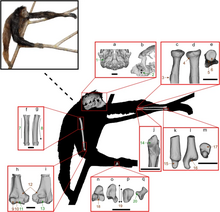

| Pliobates ↓ | |
|---|---|

| |
| Pliobates fossils and reconstruction | |
| Scientific classification | |
| Domain: | Eukaryota |
| Kingdom: | Animalia |
| Phylum: | Chordata |
| Class: | Mammalia |
| Order: | Primates |
| Suborder: | Haplorhini |
| Infraorder: | Simiiformes |
| Family: | †Pliopithecidae |
| Subfamily: | †Crouzeliinae |
| Genus: | †Pliobates Alba et al. 2015[1] |
| Species: |
†P. cataloniae
|
| Binomial name | |
| †Pliobates cataloniae Alba et al. 2015[1] | |

Pliobates cataloniae is a primate from 11.6 million years ago, during the Iberian Miocene.[1][2][3] Originally described as a species of stem-ape that was found to be the sister taxon to gibbons and great apes like humans,[1] it was subsequently reinterpreted as a non-ape catarrhine belonging to the group Crouzeliidae within the superfamily Pliopithecoidea on the basis of discovery of new dental remains with crouzeliid synapomorphies.[4]
Its anatomy is gibbon-like; prior to this discovery, it was assumed that the ancestral ape bauplan was robust like Proconsul.[5] This species has mosaic characteristics of primitive, monkey-like features and the more derived ape characteristics; however, even when originally described it wasn't interpreted as a direct ancestor of modern apes but rather a side-branch that retained the ancestral morphotype and was thus placed in its own family Pliobatidae.[6] Its subsequent placement within Pliopithecoidea indicates that it was convergent with apes in elbow and wrist morphology.[4]
| Pliobates cataloniae |
|
|---|---|
| Pliobates |
|
| Pliobatidae |
|
This prehistoric primate-related article is a stub. You can help Wikipedia by expanding it. |